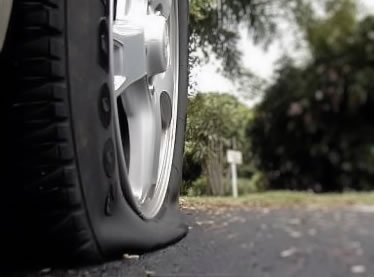Why can tyres burst and why might you get a tyre blowout? A burst tyre or tyre blowout may be the unfortunate result of hitting a kerb or pothole either at speed or at a particular angle that causes damage.
It may also be the result of hitting a loose piece of debris, particularly dangerous on fast roads such as motorways. A puncture is more common. Generally a small hole in the tyre where the air is released slowly and will often provide the driver with warning during its deflation.
Signs that you have a puncture are perhaps a shuddering of the wheel, steering pulls to one side or steering becomes heavy.
A tyre blowout is significantly more dangerous as all the air is released immediately, giving no warning and possible loss of control. If you have travelled a little by car, it is most likely that you have seen pieces of tyres by the side of the road or even on the road. These pieces are most probably the result of a tyre blowout.
Tyre blowout and what to do
As a general rule, when anything goes wrong with the car you should remain calm. A person who manages to be calm thinks much clearer and may make a decision based on better judgement rather than on panic. Even if your instinct tells you to push the brake, this is the last thing you should do if you have a tyre blowout.

You should step on the acceleration pedal but not to increase the speed but rather to keep the momentum of the car. If your back tyre is blown out and you step on the brakes, there is a great chance that your car will swerve out of control.
Stopping the car
Your task is of course to stop the car as soon as possible, but so not to endanger other road users, pedestrians and to do so in a controlled and safe manoeuvre. In the event of a tyre blowout you will have lost 25% of contact with the road surface. Your car will also be far more unstable. Try to avoid sudden and abrupt steering or braking.
Whilst keeping momentum of your vehicle by using the accelerator, keep control by keeping both hands on the wheel and you will need to ascertain an escape route. Use your mirrors – especially important if on a motorway as you will need to head towards the hard shoulder.
Once you have established an escape route and your car is stable, very gently ease off the accelerator, but avoid using the brakes. If you have a car with a manual gearbox, you should try to change down the gears from high to low in order to reduce the speed of the car.
Lift your foot off the acceleration pedal gently in order to slow down the car. This way the car will decelerate on its own. In any instance, try to find a safe area to stop the car at the side of the road or on the emergency lane.
Tyre blow-out tips
- Remain calm
- Don’t push the brake
- Gently accelerate to keep momentum
- Use the gears to slow the car
- Find a safe area to stop
Tips to avoiding a tyre blowout
A tyre blowout is a terrifying experience, even for the experienced motorist. A blowout can on many occasions be unavoidable, but a little tyre maintenance and checks can help to avoid such an experience.
- Regularly check tyre tread depth. Depth should be at least 1.6mm around the entire circumference of the tyre and at least across 3/4 of the breadth of the tyre to remain safe and legal.
- Check there are no cuts or bulges either on the outer or inner edge of the tyres. These can lead to a puncture or tyre blowout so replace if necessary.
- Avoid using old tyres. Even if a tyre looks in good condition, rubber deteriorates over time and can become weak. It is recommended to change tyres that are five years of age or over, even if they have had little use and appear in good condition.
